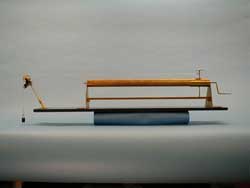Demos: 1K-02 Static and Sliding Friction

This demo shows two aspects of friction: that static friction is greater than kinetic friction and that the kinetic friction force is in the direction opposite to the velocity vector. A small weight provides tension in the string, which is attached to a brass collar fitted around a brass cylinder. The tension is insufficient to break the static friction bond. However, if the cylinder is rotated, the collar will start to move and continue to move along the cylinder at a slow uniform rate.
In the standard demonstration, an object is subjected to a force just at the breaking point and once it breaks loose, the object begins to accelerate, showing that kinetic friction is less than static friction. In this demonstration, the force on the collar from the string is considerably below the maximum static friction force, as evidenced by the fact that if you push the collar to get it started, it will immediately return to rest. However, when the cylinder is turned, the relative velocity vector between the collar and cylinder is perpendicular to the cylinder’s axis. This means that there is virtually no friction force directed along the cylinder. Thus the collar starts to move, and when it does, a small friction force is generated in that direction, keeping it at constant speed.
Directions: Place the small weight on the weight holder. Push the collar along the cylinder and release, showing that it will not continue moving. Then rotate the crank on the cylinder to start the collar moving.
Suggestions for Presentation: First, point out that the tension in the string is not sufficient to start the collar moving on the cylinder. Then show that this force is even less than the kinetic friction force that would arise if the collar merely slid down the cylinder. That’s why it stops when you stop pushing it. Now you can turn the cylinder and the collar will start to move. Ask how this could happen, given that earlier it would not slide at all.
Applications: A car moving down the highway has most of its friction resistance in the direction opposite to its velocity. If a side wind hits the vehicle and the road conditions are such that friction is quite low, the car can be blown sideways.
Last Updated: Nov 30, 2023 11:25 AM